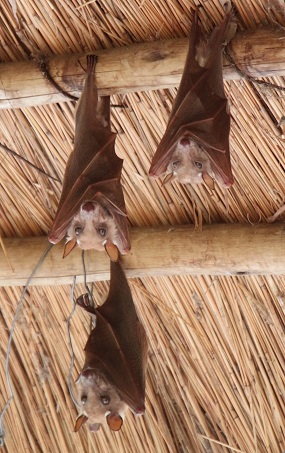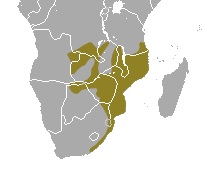
The Flying Fox of Northern Botswana
There are many species of bats in the world. They range from tiny to large. The smallest measures only 29–34 mm (1.14–1.34 in) in length and 15 cm (5.91 in) across the wings and weighs only 2–2.6 g (0.07–0.09 oz). They live all over the world except for the Arctic and Antarctic. They make up 20 per cent of all the world’s mammals, second only to the number of rodents on the planet.
Their diet ranges from small bats, which primarily eat mosquitoes and other small insects, to some that live on nectar and even some that catch fish and frogs. There is even a vampire bat that lives on blood.
Flying Foxes
The largest of the bats are fruit bats, also known as “flying foxes” because their face looks similar to a fox. The Giant Golden-crowned Flying Fox weighs in at 1.6 kg (4 lb) and a wingspan of up to 1.7 m (5 ft 7 in)
 Peters Epauletted Fruit Bat
Peters Epauletted Fruit Bat
There are more than 180 different species of fruit bats. They range from Africa to south-east Asia and Australia. The species in this article is the Peters Epauletted Fruit Bat. Within the large group of fruit bats is a small group of only a few species known as epauletted bats. An epaulette is a piece of cloth on a soldier’s uniform to display their military rank and organization. Epauletted bats are so-called because they have a white patch, like an epaulette, near their ears. Epauletted bats are found only in southern Africa. Look closely at the photos. Do you see the white epaulette? It is not on their shoulders where an epaulette should be but on their heads.
The map shows the range of the Peters Epauletted Fruit Bat.
At Sandibe Lodge in Botswana, a lovely resort, a colony of bats had made their home under a portion of the thatched roof of the open-air main building. The roof was perhaps 35 feet (10 m) above the ground. In this building, guests had several lounges and a fireplace, and breakfast, lunch and tea are served. Off to the side, away from the human traffic, several hundred bats hung suspended during the day, dozing and, at times, watching us. They weren’t in our way and never bothered us. We were never there at dusk to watch them fly away as we were away on game drives, though I think that would have been interesting. But I’ve never before in my life had the opportunity to study them as closely as during afternoons at the lodge. Fascinating!
Guest Blogger
The text for this story is a joint effort between My Thatched Hut and Dr. Fumblefinger. Dr. Fumblefinger took all the photos during his visit to Botswana. His website is here: www.travelgumbo
You can also find him on X @TravelGumbo
More posts about Bats
The cave of the Bat-eating Snakes

